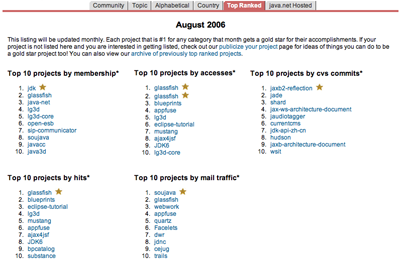New weather.com site built using AppFuse
From Jeff C (a Sr Developer for forgetaway.com, a new unit of weather.com) in Lightweight Java Development with Webwork, Spring, and iBatis:
Our new site, ForGetaway.com, launched 2 weeks ago, and its built on WebWork, Spring, and iBatis. Using those 3 frameworks as the backbone of the site was a great experience. I think that combination of frameworks can be considered lightweight, especially from a development standpoint.
...
Even the development/testing process is quick. Thanks to Matt Raible's AppFuse (which was used to get this app started), we have a sweet build.xml file that allows us (on our dev machines) to reload our app by having the build script talk to tomcat. So, even when a properties file or java class or static field changes, its just a matter of running the reload task in the build.xml file and tomcat reloads the app with all changes in under 5 seconds. Yeah, rails is probably quicker, but i can spare 5 seconds of my time to let my changes get reloaded by tomcat.
Reloading your application in Tomcat to see your changes sucks. However, AppFuse 2.0 will allow you to use the Maven 2 Jetty Plugin, which aims to eliminate the whole deploy cycle. This plugin is powered by Jetty 6, which has been rewritten for Continuations, NIO, Servlet 2.5. Hopefully we'll start to see more appserver plugins written for Maven 2.
I love hearing success stories like Jeff's. That's why I (and many others) work on AppFuse - to simplify Java web development. We know that it's more painful to develop web applications in Java than in scripting languages, but we continue to do it because tools like AppFuse make it enjoyable. Even though tools and languages are important for simplification, I believe that most project's success is determined by people. If you have good people, effective processes and a lack of politics - a project should have no problem being successful, regardless of the tools.
Did you know the new SourceBeat site is also powered by AppFuse? We chose the WebWork+Spring+Hibernate combination and were quite pleased at how easy it was to develop everything. We had 90% of the site done in the first two weeks of development.
In other AppFuse-related news, the demos have been running solid for 70 days straight. I'll admit that's not a very log time, but it does prove there's no memory or connection leaks in the software.  The number of currently active sessions is as follows:
The number of currently active sessions is as follows:
- /appfuse (Struts): 456
- /appfuse-jsf: 206
- /appfuse-spring: 105
- /appfuse-tapestry: 94
- /appfuse-webwork: 178
- /spring-kickstart: 17
- /struts-resume: 36
- /wiki: 256
The default session timeout is set to 10 minutes in AppFuse.


